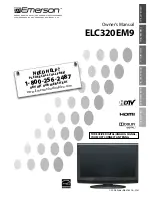
144
7.
Circuit Diagrams and PWB Layouts
SSB: SRP List Explanation
1.1. Introduction
Example
SRP (Service Reference Protocol) is a software tool that creates a list with all references to signal lines. The list contains
references to the signals within all schematics of a PWB. It replaces the text references currently printed next to the signal
names in the schematics. These printed references are created manually and are therefore not guaranteed to be 100%
correct. In addition, in the current crowded schematics there is often none or very little place for these references.
Some of the PWB schematics will use SRP while others will still use the manual references. Either there will be an SRP
reference list for a schematic, or there will be printed references in the schematic.
1.2. Non-SRP Schematics
There are several different signals available in a schematic:
1.2.1.
Power Supply Lines
All power supply lines are available in the supply line overview (see chapter 6). In the schematics (see chapter 7) is not
indicated where supplies are coming from or going to.
It is however indicated if a supply is incoming (created elsewhere), or outgoing (created or adapted in the current schematic).
+5V
+5V
Outgoing
Incoming
1.2.2. Normal
Signals
For normal signals, a schematic reference (e.g. B14b) is placed next to the signals.
signal_name
B14b
1.2.3. Grounds
For normal and special grounds (e.g. GNDHOT or GND3V3 etc.), nothing is indicated.
1.3. SRP
Schematics
SRP is a tool, which automatically creates a list with signal references, indicating on which schematic the signals are used.
A reference is created for all signals indicated with an SRP symbol, these symbols are:
+5V
+5V
Power supply line.
name
name
Stand alone signal or switching line (used as less as possible).
name
name
Signal line into a wire tree.
name
name
Switching line into a wire tree.
name
Bi-directional line (e.g. SDA) into a wire tree.
name
Signal line into a wire tree, its direction depends on the circuit (e.g. ingoing for PDP, outgoing for LCD sets).
Remarks:
•
When there is a black dot on the "signal direction arrow" it is an SRP symbol, so there will be a reference to the signal
name in the SRP list.
•
All references to normal grounds (Ground symbols without additional text) are not listed in the reference list, this to keep
it concise.
•
Signals that are not used in multiple schematics, but only once or several times in the same schematic, are included
in the SRP reference list, but only with one reference.
Additional Tip:
When using the PDF service manual file, you can very easily search for signal names and follow the signal over all the
schematics. In Adobe PDF reader:
•
Select the signal name you want to search for, with the "Select text" tool.
•
Copy and paste the signal name in the "Search PDF" tool.
•
Search for all occurrences of the signal name.
•
Now you can quickly jump between the different occurrences and follow the signal over all schematics. It is advised to
"zoom in" to e.g. 150% to see clearly, which text is selected. Then you can zoom out, to get an overview of the complete
schematic.
PS.
It is recommended to use at least Adobe PDF (reader) version 6.x, due to better search possibilities in this version.
E_06532_031.eps
230606
Net Name
Diagram
+12-15V AP1
(4x)
+12-15V AP4
(4x)
+12-15V AP5
(12x)
+12-15V AP6
(4x)
+12-15V AP7
(8x)
+12V AP1
(4x)
+12V_NF AP1
(2x)
+12VAL AP1
(2x)
+25VLP AP1
(4x)
+25VLP AP2
(1x)
+3V3-STANDBY AP5
(3x)
+400V-F AP1
(2x)
+400V-F AP2
(2x)
+400V-F AP3
(2x)
+5V2 AP1
(6x)
+5V2 AP2
(1x)
+5V2-NF AP1
(1x)
+5V2-NF AP2
(1x)
+5V-SW AP1
(6x)
+5V-SW AP2
(1x)
+8V6 AP1
(3x)
+AUX AP1
(2x)
+AUX AP2
(1x)
+DC-F AP1
(2x)
+DC-F AP3
(2x)
+SUB-SPEAKER AP5
(1x)
+SUB-SPEAKER AP6
(2x)
-12-15V AP1
(4x)
-12-15V AP4
(6x)
-12-15V AP5
(14x)
-12-15V AP6
(6x)
-12-15V AP7
(8x)
AL-OFF AP1
(2x)
AUDIO-L AP4
(1x)
AUDIO-L AP5
(1x)
AUDIO-PROT AP5
(3x)
AUDIO-R AP4
(1x)
AUDIO-R AP5
(1x)
AUDIO-SW AP5
(1x)
AUDIO-SW AP7
(1x)
BOOST AP1
(2x)
CPROT AP4
(2x)
CPROT AP5
(1x)
CPROT-SW AP5
(1x)
CPROT-SW AP6
(2x)
-DC-F AP1
(2x)
-DC-F AP3
(2x)
DC-PROT AP1
(1x)
DC-PROT AP5
(2x)
DIM-CONTROL AP1
(2x)
FSW AP6
(2x)
FEEDBACK-L AP4
(2x)
FEEDBACK-R AP4
(2x)
FEEDBACK-SW AP6
(2x)
GND-AL AP1
(2x)
GNDHA AP1
(40x)
GNDHA AP2
(20x)
GNDHA AP3
(2x)
GNDHOT AP3
(2x)
GND-L AP1
(2x)
GND-L AP4
(4x)
GND-L AP5
(34x)
GND-LL AP4
(7x)
GND-LL AP5
(1x)
GND-LR AP4
(7x)
GND-LR AP5
(1x)
GND-LSW AP5
(1x)
GND-LSW AP6
(15x)
GND-S AP1
(11x)
GND-SA AP4
(8x)
GND-SA AP5
(2x)
GND-SA AP6
(8x)
GND-SA AP7
(6x)
GNDscrew AP3
(2x)
GNDscrew AP5
(2x)
GND-SSB AP5
(3x)
GND-SSP AP1
(51x)
GND-SSP AP2
(15x)
IN+SW AP6
(2x)
IN-L AP4
(2x)
IN-R AP4
(2x)
IN-SW AP6
(2x)
INV-MUTE AP4
(1x)
INV-MUTE AP5
(1x)
INV-MUTE AP6
(1x)
LEFT-SPEAKER AP4
(1x)
LEFT-SPEAKER AP5
(1x)
MUTE AP4
(2x)
MUTE AP5
(1x)
MUTE AP6
(2x)
ON-OFF AP1
(3x)
OUT AP6
(1x)
OUT AP7
(2x)
OUTN AP6
(1x)
OUTN AP7
(1x)
POWER-GOOD AP1
(2x)
POWER-OK-PLATFORM AP1
(2x)
RIGHT-SPEAKER AP4
(1x)
RIGHT-SPEAKER AP5
(1x)
SOUND-ENABLE AP5
(3x)
STANDBY AP1
(5x)
STANDBY AP2
(1x)
-SUB-SPEAKER AP5
(1x)
-SUB-SPEAKER AP6
(2x)
V-CLAMP AP1
(1x)
V-CLAMP AP3
(2x)
















































